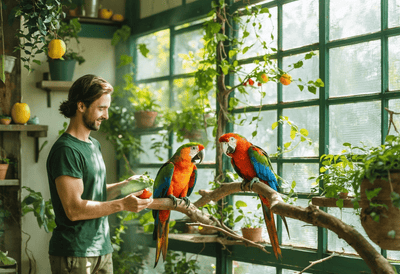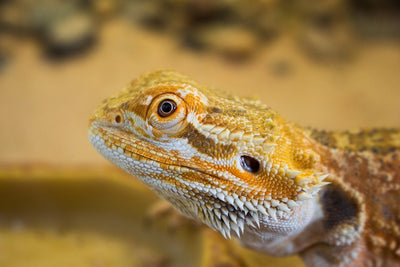Introduction to Iguana Enclosure Importance

Selecting an appropriate iguana enclosure size is critical for the health and wellbeing of these reptiles. Proper space allows iguanas to engage in natural behaviors, which is essential for their physical and psychological health. Conversely, cramped conditions can lead to stress, obesity, and other health issues. Pet owners often overlook the significance of vertical space, ventilation, and the future growth of iguanas, leading to inadequate habitats that impede their pets' quality of life.
Understanding Iguana Growth and Space Needs
Iguanas are known for their impressive growth, evolving from a mere handful at birth to potentially six feet in length as adults. This rapid and significant increase in size has direct consequences for their living space. Owners must anticipate these changes and plan accordingly to ensure that their reptilian companions have ample room to grow and thrive. An enclosure that seems spacious for a young iguana can quickly become restrictive, limiting their ability to move freely and exhibit natural behaviors.
Physical activity is vital for iguanas, not just for their physical health but also for their mental wellbeing. A proper enclosure allows for the full range of motion, including climbing, which is an instinctual activity for these arboreal creatures. The vertical dimension of their habitat is just as crucial as the floor space. An iguana that cannot climb is deprived of a fundamental aspect of its nature, leading to possible stress and behavioral issues.
As iguanas mature, their space requirements evolve. Owners should provide progressively larger enclosures to accommodate their growth, with the goal of replicating the iguana's natural environment as closely as possible. This includes incorporating branches for climbing and basking, as well as areas for retreat to mimic the iguana's interaction with its habitat in the wild. The end result is a more content and healthy iguana, displaying vibrant colors and active behaviors that indicate a thriving life in captivity.
The Ideal Enclosure Size for a Juvenile Iguana
Ensuring the wellbeing of a juvenile iguana begins with providing an appropriate living space that caters to their growth and developmental needs. The recommended dimensions for a juvenile iguana's enclosure are a minimum of 6 feet in length, 2 feet in width, and 3 feet in height. These proportions offer ample room for the young reptile to move freely, explore, and engage in natural behaviors, which is crucial for their physical health.
As iguanas are arboreal by nature, vertical space is as important as horizontal ground space. The height of the enclosure facilitates climbing activities, an essential aspect of a juvenile iguana's life that encourages muscle development and coordination. Furthermore, the spaciousness of the enclosure affords the opportunity for owners to install branches and shelves, thereby simulating an iguana's natural habitat and promoting a sense of security and comfort for the growing reptile.
Providing an enclosure of these dimensions also has a direct impact on the iguana's health. A spacious environment reduces stress, which is vital in preventing health issues and encouraging a robust immune system. It also allows for proper thermal regulation, as iguanas require different temperature zones within their habitat to regulate their body temperature effectively. In conclusion, the ideal enclosure size for a juvenile iguana is not just about physical space, but about creating a supportive environment for their overall health and wellbeing.
Transitioning to Adult Iguana Enclosures
As iguanas mature, their world expands beyond the confines of a juvenile habitat. Recognizing when and how to modify their living quarters is crucial for their continued health and wellbeing. Adult iguanas require significantly more space, not only to accommodate their larger physical size but also to provide ample room for exercise, exploration, and normal behavioral patterns.
The decision to upscale an iguana’s enclosure should be timed with their growth spurt, typically noticeable as they reach sexual maturity. This growth phase demands an upgrade to a spacious environment where they can move freely. It's essential to anticipate this change and plan accordingly, as a delay in providing appropriate space can lead to stress, obesity, and other health issues in iguanas.
When considering new enclosures, owners should seek out designs that allow their reptilian companions to stretch, climb, and bask as they would in their natural habitat. As iguanas are arboreal, vertical space is just as important as the floor area. The transition is not just about bigger dimensions; it's about creating a habitat that supports the iguana's instinctual needs.
Ultimately, the transition to an adult iguana enclosure is a step towards fostering a nurturing and growth-conducive environment. It's an investment in the health and happiness of these majestic creatures, ensuring they have a home that caters to their physical and psychological needs as they continue to thrive under your care.
Top 5 Recommended Enclosure Sizes for Adult Iguanas
When it comes to providing a home for your adult iguana, space is a significant factor in ensuring a thriving environment. Adult iguanas require ample room to move, climb, and exhibit natural behaviors, which is why selecting the proper enclosure size is critical to their well-being. Here, we detail the five best enclosure sizes for adult iguanas, highlighting the benefits of each to help you make an informed decision for your reptilian companion.
The first ideal size for an adult iguana enclosure is one that measures at least 12 feet in length, 6 feet in width, and 6 feet in height. This size allows for a variety of climbing structures and ample space for the iguana to move freely, which is essential for their physical health and mental stimulation.
Following closely is an enclosure that is 8 feet long, 4 feet wide, and 6 feet tall. While slightly smaller, this space still provides sufficient room for your iguana to exercise and explore. It's a suitable option for those who may have space constraints but still want to provide a quality habitat.
Another recommended size is an enclosure that spans at least 10 feet in length, 5 feet in width, and 6 feet in height. This mid-sized option strikes a balance between space for the iguana and the practicalities of indoor housing, making it a popular choice among iguana owners.
For iguana enthusiasts who can afford more room, an enclosure measuring 14 feet by 7 feet by 6 feet offers a luxurious habitat for your pet. This expansive space supports a diverse range of flora and fauna, enhancing the enclosure's ecosystem and providing a more naturalistic setting for your iguana.
The fifth enclosure size to consider is a custom-built habitat that exceeds the minimum recommendations. Tailoring the dimensions to your iguana's needs and your available space can create a truly unique and enriching environment. This option allows for the inclusion of advanced features such as waterfalls, large basking areas, and varied vegetation.
Each of these enclosure sizes caters to different types of iguanas and owner circumstances. From the more common green iguanas that appreciate vertical space for climbing to the bulkier rock iguanas that may require wider floor space, it's crucial to choose an enclosure that aligns with the specific needs of your pet. By offering an appropriate habitat, you contribute to the long-term health and happiness of your iguana, ensuring they lead a content and active life.
Customizing Your Iguana's Habitat Within the Enclosure
Creating a personalized habitat within your iguana's enclosure is essential for their enrichment and comfort. It's not just about the space an iguana occupies; it's about how you optimize that space to encourage natural behaviors and promote well-being. A crucial aspect of this customization involves incorporating vertical space and various accessories that facilitate climbing—a favorite activity for these arboreal reptiles.
Begin by considering the vertical dimension of the habitat. Iguanas are inherently inclined to climb and explore heights, and your enclosure should cater to this tendency. Install branches, shelves, and even hammocks at different levels to satisfy their climbing instincts. Ensure these installations are secure and able to support the weight of your growing reptile friend.
Accessories play a pivotal role in mimicking an iguana's natural environment. Use a variety of textures and sizes for branches and climbing apparatus to keep the iguana engaged and active. Rocks and basking platforms also contribute to a more dynamic and interactive habitat. These not only serve as tools for exercise but also double as ideal lounging spots for thermoregulation.
Remember, personalizing your iguana's environment is a continuous process. As they grow and their needs evolve, so should their space. Regularly assess the habitat's layout and make adjustments to ensure it remains a stimulating and comforting sanctuary for your reptilian companion.
Common Design Problems to Avoid in Iguana Cages
When creating a habitat for your iguana, certain design flaws can hinder their health and happiness. A well-thought-out enclosure goes beyond aesthetics; it's about meeting the fundamental needs of your reptile companion. One of the most critical aspects to consider is the size of the cage. Iguanas require ample space to move, climb, and explore, so a small, cramped enclosure is not only inadequate but can also lead to stress and health issues for your pet.
Another vital aspect is ventilation. Proper air circulation is essential for maintaining a healthy environment. Enclosures lacking sufficient airflow can become humid and stagnant, which can promote the growth of mold and bacteria, potentially leading to respiratory problems in iguanas. To prevent these issues, ensure that the enclosure you choose has a well-designed ventilation system.
While considering the aesthetic appeal of the iguana's home, functionality must never be compromised. An iguana's enclosure should be a sanctuary where it feels safe, can perform natural behaviors, and has access to necessities like fresh water and a basking area. It's not just about avoiding pitfalls; it's about actively creating an environment where your iguana can thrive.
Enclosure Maintenance and Upkeep for Iguana Health
Maintaining an iguana enclosure is not just about keeping it clean; it's a vital part of ensuring your iguana's health and extending the life of their habitat. A well-kept enclosure mirrors the iguana's natural environment, promoting both physical and mental well-being. The practice of routine maintenance involves regular cleaning, inspection for wear or damage, and the updating of habitat components to suit the iguana's growing needs.
Regular cleaning of the enclosure prevents the buildup of harmful bacteria and parasites that can lead to disease. This includes removing waste, uneaten food, and shed skin. Additionally, ensure that the water features, if any, are kept clean to prevent the growth of algae and bacteria. It's also important to disinfect the enclosure thoroughly with a reptile-safe cleaner to eliminate potential pathogens. This rigorous routine contributes significantly to the iguana's overall health.
Another aspect of maintenance is the inspection of the enclosure for any signs of wear or damage, such as cracks or breaks, which could potentially injure your iguana or allow them to escape. The habitat's structural integrity should be solid, with all locks and fasteners secure. Moreover, as iguanas grow, so should their environment. Adjustments and enhancements to the enclosure, such as adding larger basking platforms or more intricate climbing structures, will cater to the iguana's development and encourage natural behaviors.
Proper upkeep directly affects the longevity of the enclosure itself. High-quality materials and a robust design can withstand the test of time, but they also require diligent care. By adhering to a strict maintenance schedule, you can avoid premature wear and tear, ensuring that the enclosure remains a safe and comfortable home for your iguana for years to come.
In summary, regular and thorough maintenance of an iguana enclosure is crucial for the health of your reptile companion. By establishing a routine that includes cleaning, inspecting, and updating the habitat, you provide your iguana with an environment that not only mimics their natural ecosystem but also evolves with them throughout their life.
Additional Considerations: Heating, Lighting, and Humidity
Creating an environment that closely mirrors an iguana’s natural habitat is not only beneficial but essential for their health and wellbeing. The aspects of heating, UVB lighting, and humidity play pivotal roles in this process, each one contributing uniquely to the iguana's enclosure ecosystem. To ensure your iguana thrives, understanding and implementing these elements in accordance with the size of your enclosure is paramount.
Heating is a critical component as it regulates an iguana’s body temperature, aiding in digestion and overall physiological function. An ideal temperature gradient allows your reptile friend to thermoregulate by moving between warmer and cooler areas within the enclosure. For larger spaces, this may mean multiple heat sources to maintain consistent temperatures throughout.
UVB lighting, on the other hand, is indispensable for iguanas to synthesize vitamin D3, which in turn enables calcium absorption — a necessity for strong bone development and prevention of metabolic bone disease. The larger the enclosure, the more strategic you must be about the placement of UVB lights to ensure your iguana receives adequate exposure wherever it chooses to bask.
Lastly, maintaining the correct humidity levels is crucial for iguanas, particularly because it supports their respiratory health and skin shedding process. In larger enclosures, humidifying can become a challenge, necessitating a reliable system that uniformly distributes moisture, such as a fogger or mister, especially in areas that are farther away from water sources.
By addressing these additional considerations thoughtfully, you create a habitat that not only accommodates your iguana's size but also supports its complex biological needs. A thriving iguana is a testament to a well-maintained enclosure that aligns with these vital environmental factors.
Where to Find Suitable Enclosures and Accessories
Finding the right enclosure and accessories for your iguana can be a daunting task, but it's crucial for their health and happiness. As iguana enthusiasts seek to create the ideal habitat, they need a reliable source for high-quality products. This is where Talis-us comes into play. Our webpage is a treasure trove of reptile-related products, designed to cater to the specific needs of your scaly companion.
We understand that an iguana's home is more than just a space—it's a crucial part of their environment that must simulate their natural habitat to ensure they thrive. That's why we encourage iguana owners to explore our extensive range of products. From spacious enclosures that provide ample room for movement to accessories that promote climbing and basking, our selection is tailored to enhance your iguana's quality of life.
Our commitment to your iguana's wellbeing is reflected in the variety of housing accessories we offer. We recognize the importance of vertical space for these arboreal creatures and provide options that allow them to climb and explore as they would in the wild. By choosing from our carefully curated selection, you can construct a sanctuary that not only meets but exceeds the needs of your reptilian pet.
We invite you to browse our webpage and consider the thoughtful design and variety of our iguana-centric products. With Talis-us, you're not just purchasing a product; you're investing in your iguana's future. Create a space where your iguana can not only live but flourish.
Your Iguana's Happiness
Choosing the right iguana enclosure size is critical for the welfare of your scaly friend. As an iguana owner, it's your responsibility to assess and adapt your pet's environment continually to ensure it meets their growing needs. A spacious and well-designed habitat is essential for their physical health and mental well-being. For those dedicated to nurturing a thriving reptile, visit our reptile care page for habitat accessories and expert guidance on creating the perfect iguana environment.






